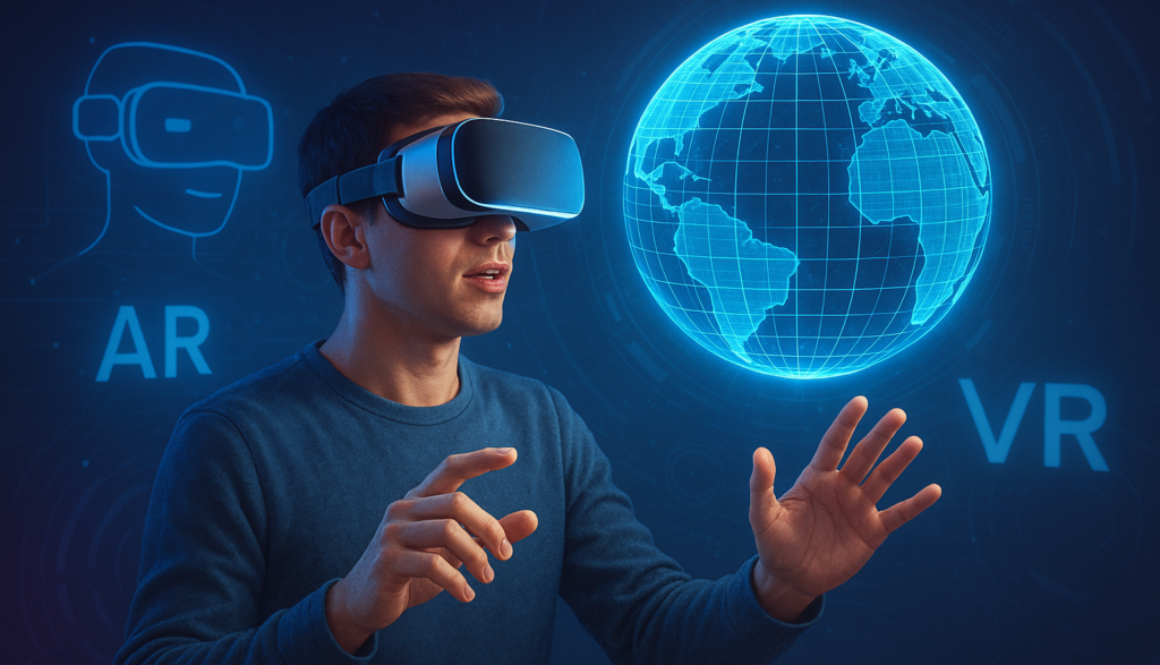Advancements in Augmented and Virtual Reality (AR/VR)
Introduction
Augmented Reality (AR) and Virtual Reality (VR) have revolutionized numerous industries, from entertainment and gaming to healthcare and education. The evolution of these technologies has been fueled by advancements in computing power, artificial intelligence, and sensor technology. This article explores the latest developments in AR and VR, their applications, challenges, and the future of immersive experiences.
Understanding AR and VR
AR overlays digital content onto the real world, enhancing the user’s perception of their surroundings. VR, on the other hand, creates a completely immersive digital environment that isolates users from the real world. Both technologies rely on hardware such as headsets, sensors, and controllers, along with software that enables real-time interaction and rendering.
Historical Background
The concept of VR dates back to the 1960s with early head-mounted displays (HMDs) developed by Ivan Sutherland. AR gained prominence in the 1990s with the advent of military applications and later became mainstream through mobile devices. The rise of smartphones and improved computing capabilities led to widespread adoption of AR and VR.
Recent Technological Advancements
1. Hardware Improvements
Higher Resolution Displays: Companies like Meta, Apple, and HTC have developed high-resolution OLED and microLED displays for enhanced realism.
Lighter and More Ergonomic Headsets: Devices such as the Apple Vision Pro and Meta Quest 3 focus on comfort and usability.
Eye and Hand Tracking: Advanced sensors enable natural interactions and reduce the need for controllers.
2. Software Enhancements
AI-Driven AR/VR: Machine learning enhances object recognition, scene understanding, and real-time adjustments.
Cloud-Based AR: 5G connectivity allows AR content to be streamed from the cloud, reducing device processing needs.
Realistic Physics and Haptics: Improved algorithms enhance realism by simulating physics-based interactions.
3. Spatial Computing
Apple’s Vision Pro and Microsoft’s HoloLens focus on spatial computing, enabling users to interact with 3D holograms and virtual objects naturally.
4. Mixed Reality (MR)
MR merges AR and VR, allowing real and virtual elements to coexist interactively. Microsoft’s HoloLens and Meta’s Reality Labs are at the forefront of MR development.
Applications of AR/VR
1. Gaming and Entertainment
Immersive Gaming: Games like Half-Life: Alyx and Beat Saber utilize VR to provide unparalleled experiences.
Virtual Concerts and Events: Platforms like Wave and Meta Horizon Worlds enable virtual live performances.
2. Healthcare
Surgical Training and Simulation: VR provides realistic training for medical professionals.
Pain Management and Therapy: VR environments help patients with PTSD and chronic pain management.
3. Education and Training
Virtual Classrooms: Institutions use VR for interactive learning experiences.
Corporate Training: Companies leverage VR for employee training in hazardous environments.
4. Retail and E-Commerce
Virtual Try-Ons: AR enables customers to try on clothing, glasses, and makeup virtually.
Enhanced Shopping Experiences: Retailers use AR to provide 3D product visualization.
5. Real Estate and Architecture
Virtual Property Tours: Prospective buyers can explore properties in VR before making a purchase.
AR for Interior Design: Homeowners can visualize furniture placements before buying.
6. Manufacturing and Engineering
Digital Twins: AR enables real-time monitoring and simulation of physical assets.
Remote Assistance: AR-powered remote support aids technicians in repairs and maintenance.
7. Automotive Industry
AR Navigation: Vehicles incorporate AR-based heads-up displays for real-time navigation.
VR Design Prototyping: Car manufacturers use VR for vehicle design and testing.
8. Military and Defense
AR Tactical Displays: Soldiers use AR goggles for situational awareness.
VR Combat Training: VR simulations provide realistic training for defense personnel.
Challenges and Limitations
1. Hardware Limitations
Cost: High-end AR/VR devices remain expensive.
Battery Life: Prolonged usage is limited by battery constraints.
Motion Sickness: VR-induced nausea remains a challenge for some users.
2. Software and Content Limitations
Lack of Standardization: Different platforms use varied AR/VR development frameworks.
Content Creation: High-quality content requires significant investment.
3. Privacy and Security Concerns
Data Collection Risks: AR/VR devices collect large amounts of user data.
Cybersecurity Threats: Virtual environments are prone to cyberattacks and data breaches.
4. User Adoption and Accessibility
Learning Curve: Users require time to adapt to AR/VR interfaces.
Physical Space Requirements: VR experiences may need large areas for movement.
Future Trends
1. Metaverse Development
Tech giants like Meta and Microsoft are investing in metaverse platforms that integrate AR/VR for social interaction, business, and entertainment.
2. AI-Driven Enhancements
Artificial intelligence will continue to improve AR/VR realism, automation, and user interactions.
3. Brain-Computer Interfaces (BCI)
Companies like Neuralink are exploring BCIs to create direct neural interactions with AR/VR systems.
4. 5G and Edge Computing
Faster connectivity will enable real-time rendering and cloud-based AR/VR applications.
5. Affordable and Lightweight Devices
Advancements in material science and microchip manufacturing will drive the development of more affordable and portable AR/VR headsets.
6. AR Glasses for Everyday Use
Companies like Apple, Google, and Meta are working on AR smart glasses that will replace smartphones for daily activities.
Conclusion
The advancements in AR and VR are shaping the future of human-computer interaction. While challenges remain, continuous technological innovations promise to expand their applications across various sectors. As AR and VR continue to evolve, they will redefine how we work, learn, and engage with the digital world.





